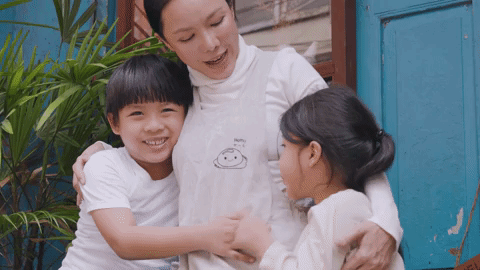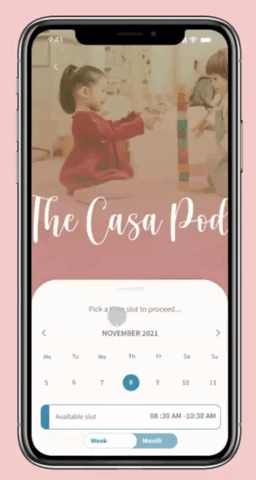UX: How improving the toddlers’ fun and friendly social environment benefits child care industry revenue.
Role: UX designer, UX Researcher, UI designer
Duration: 11 months
Tools: Figma, Miro, Slack, Google Drive, Zoom
In my personal life, I am a wife and mother to my 30 months young son who goes to a Montessori school. We were happy with the way his early childhood was taking shape and how he was learning and making progress with his school.
A toddler attending a Montessori School before the pandemic
Yet, in March of 2020 came COVID-19. We were forced to go online with distance learning for our son. We had to stay at home for quarantine and worked from home, too. All this practically without childcare help.
We were stressed. Managing our home, work, and taking care of our son’s development scared our family. As it turns out, we were not alone in experiencing this.
So, I recruited 5 parents and interviewed each one. Here’s what I found:
Not only was distance learning not working out for their toddlers, but it was stressful to manage work as well. The toddler would either NOT sit in front of the screen or would start playing with the device itself. Parents were sitting with them momentarily during classes often leaving their work neglected. This was very stressful for them to manage work and take care of their child’s development at the same time. So, what next?
A toddler learning baking over distance learning.
In our study, we found parents could see the same stress and sadness building up in their children, too.
Toddlers were unable to express themselves at this age; however, they were noticeably upset. The toddlers’ once favorite toys were no longer their favorites. Parents bought new toys, focused on learning, but nothing helped. Here are some of the more common patterns that emerged during our primary qualitative research.
Children were drawn to screens more than ever,
Parents worried their kids were missing socialization,
Managing both a child’s holistic development and a full-time job is difficult.
These key points concerned all of the parents interviewed.
Next, let’s look at how “screen time” affects the situation.
Toddler attracted to screens more leaving aside her favorite toys.
71% of parents in the U.S. with children under 12 were concerned their child was spending too much time in front of a screen. — According to Pew research
To make matters worse, a study by the National Institute of Health shows children who spend between 2 and 7 hours a day on screen experience…
Lower language and thinking test scores, and
Thinning of the brain’s cortex (the area of the brain related to critical thinking and reasoning.)
That’s not the end of it.
Another study from Harvard Medical School states,
“More screen time leads to Attention deficit hyperactivity disorder (ADHD)”
Not only is screen time a problem, but the study goes on taking a look at how parents are worried about their kids’ lack of socialization.
Now, let’s put ourselves in the shoes of what it’s like to be this parent. Imagine, while bouncing between your full-time job and your kid’s schoolwork, you have an emotional breakdown. You are unable to help your kid. You feel sad, stressed, anxious, afraid, helpless, and inadequate as a parent.
Now, do you know what it’s like to be this parent?
So, I’d like for you to meet Zara and her children Noah and Jewel.
Zara tries to help by purchasing some learning tools, books, toys, and apps. Yet, very soon she realizes her toddlers are missing socialization.
Her heart breaks when they point towards another child and ask “Mommy, can we play?” She feels sad about telling them, “No.” She feels sad about her toddlers missing out on socialization with their peers.
Needing to send her toddlers to school Zara remains sad for not being able to do so. She needs to give them time to socialize, yet she works full time and so she is unable to. She feels inadequate. So…
How might we socialize Noah and Jewel so Zara feels happy?
Today, I’d like to introduce you to Poddler:
Poddler was our first attempt at solving Zara’s toddler’s socialization issue.
It is a socializing platform that helps toddlers socialize safely with their peers off the screen. The platform facilitates Zara search and lets her toddlers participate in the PODs nearby to socialize with their peers.
Zara came to pick Noah and Jewel up after the POD and she is so happy looking her kids had so much fun!
To test the looks like a prototype, we recruited 5 Zaras, and the following were the results:
Labeling icons helps to understand
While booking a POD Zara got lost. She didn’t understand the icon. She was struggling to pick a date. When going back it was taking her to an unsuspected screen. Here is a look at it …
Before
Next, Let’s take a look at how we change the design to accommodate Zara. Here is a look at it…
After
How Visual hierarchy leads to task performance
Zara seemed to have missed reading the button to get directions and ended up booking more PODs. And was unable to pull the directions.
Before
Next, let’s take a look at how Zara was able to pull the directions smoothly.
After
How Consistency in button usage reduces confusion.
Initially, Zara was unable to understand the ‘on drag’ interaction. Her expectation was a visible and clickable button.
Before
Here you can see, by making the button visible Zara is able to understand and thus, perform the task more efficiently.
After
Conclusion:
Labeling the icon helps to understand the purpose,
Keeping minimum screen transitions eases the intended function, and
Minimalistic and simple design improves efficiency.
Consistency in buttons reduces confusion.
Next, we did a works-like prototype test for Noah and Jewel to socialize in a POD setting. Read further at— Service Design of Poddler.











